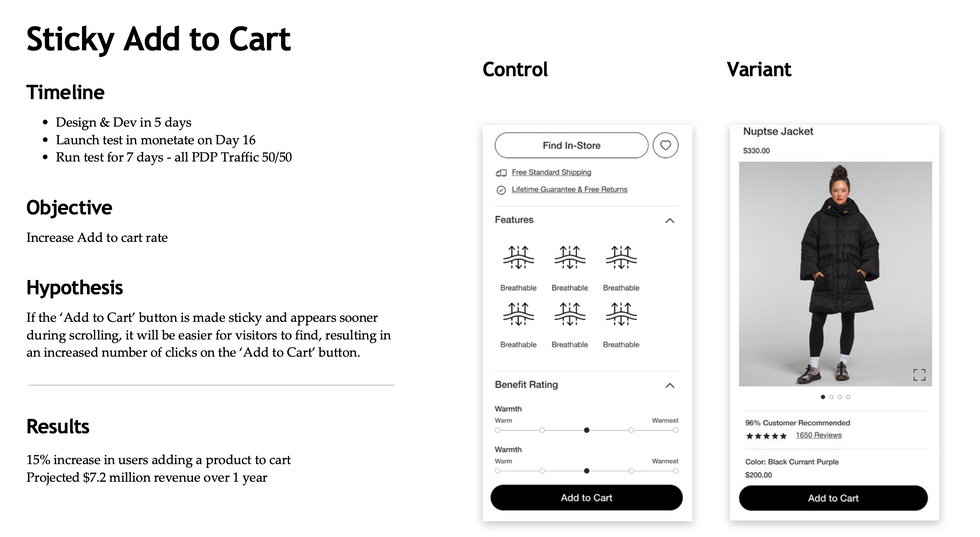How I helped unlock $7M+ for The North Face Through Agile eCommerce Optimization
- Melissa Kerr
- Sep 17, 2024
- 4 min read
Updated: Aug 10
In the fast-moving world of digital commerce, speed and precision are everything. That’s why The North Face, in partnership with a small scrappy team, led in part by myself and in partnership with consultants from The Boston Consultant Group (BCG), launched Project Ascent—an 8-week pilot initiative designed to dramatically improve how eCommerce tests are developed, launched, and scaled. The results speak for themselves: faster test cycles, better collaboration, and over $7 million in projected revenue gains.

The Challenge
For many brands, testing new features or optimizations is a slow, fragmented process. Limited technical resources, delayed development timelines, and a lack of clear ROI tracking often stand in the way of innovation. The North Face was no exception.
The Ascent Approach

To overcome these barriers, the Ascent team brought together a dedicated, cross-functional group of UX designers, developers, analysts, and brand stakeholders. This team worked in agile sprints, enabling them to move fast, prioritize high-impact ideas, and get test results in weeks—not months. Our goal was to make sure tests take no longer than one (2 week) sprint to develop, with UX staying at least one sprint ahead.
THE PROCESS, WHAT WE DID
Through team partnership, the ascent team came together to brainstorm over 100 ideas. We gathered ideas from Brand and from consumer surveys. Developers, ux and qa also added their ideas from what they’ve seen on other sites, what they’ve been wanting to try out, ecomm trends and best practices. We took all these ideas and prioritized them based on Business Value (BV), Level of Effort (LOE) and Projected Impact.

We Established new ways of working
Team members were chosen based on their expertise & experience from 6 different specialties into what I like to call a POD. We met daily and developed new methods of collaboration that ensure each team member felt valued and contributes meaningfully to the team.
We have delivered value faster, 13x faster. Where it used to take 6 months, we can do it in 2 weeks, we have succeeded in this fast paced environment by eliminating the barriers that often exist between squads.
Our goal was 5-6 tests and we have launched 6 tests, 4 have concluded and 2 are currently running.
Lastly we've exceeded our revenue goal with just one very successful test, projecting out a $7.2 million dollar revenue impact over the next year, and with several more tests in the works, this number will keep going up.

Real Impact, Real Fast
In just 8 weeks, the Ascent team completed six A/B tests (four concluded, two in progress) that tackled key parts of the shopping journey—from product pages to checkout.
Highlights include:
Sticky Add to Cart (ATC) : Made the ATC button persistent on product pages, resulting in a 15% lift in ATC rate and a projected $7.2M in annual revenue.
Skip the Checkout Review Step : Removed friction by allowing users to place orders right after entering payment. While conversions remained steady, time to purchase dropped by 9.75%.
Scarcity Messaging : Alerted users when stock was low. Although only a portion of users saw it, those who did were more likely to convert.
Not every experiment succeeded—one test that added product pricing to the CTA actually underperformed. But that’s the power of experimentation: Learn quickly, Adapt faster.
Why It Worked
By embedding the right resources into one agile team, Project Ascent created a feedback loop that was fast, flexible, and focused on business value. Ideas were prioritized based on effort vs. impact, and UX, dev, and analytics stayed tightly aligned throughout.
What’s Next
With a proven model and documented results, The North Face and DT are scaling the Ascent approach. The focus now is on systematizing learnings, continuing rapid experimentation, and expanding to new areas of the customer journey.
What gets me the most excited about this project is also our continuous tracking, the Ascebnt team will continue to monitor at 30 and 60 day intervals to ensure the new feature is still performing optimally, if we see a decline, it will be a sign to review, ititate and test again.
—
Project Ascent is more than a pilot—it's a blueprint for how brands can unlock digital growth through better teamwork, smarter testing, and relentless focus on the customer experience.
Starting in January 2025, we have expanded the Ascent team to include two regions, two teams in AMER and EMEA, and three brands - The North Face, Vans and Timberland.
















Comments